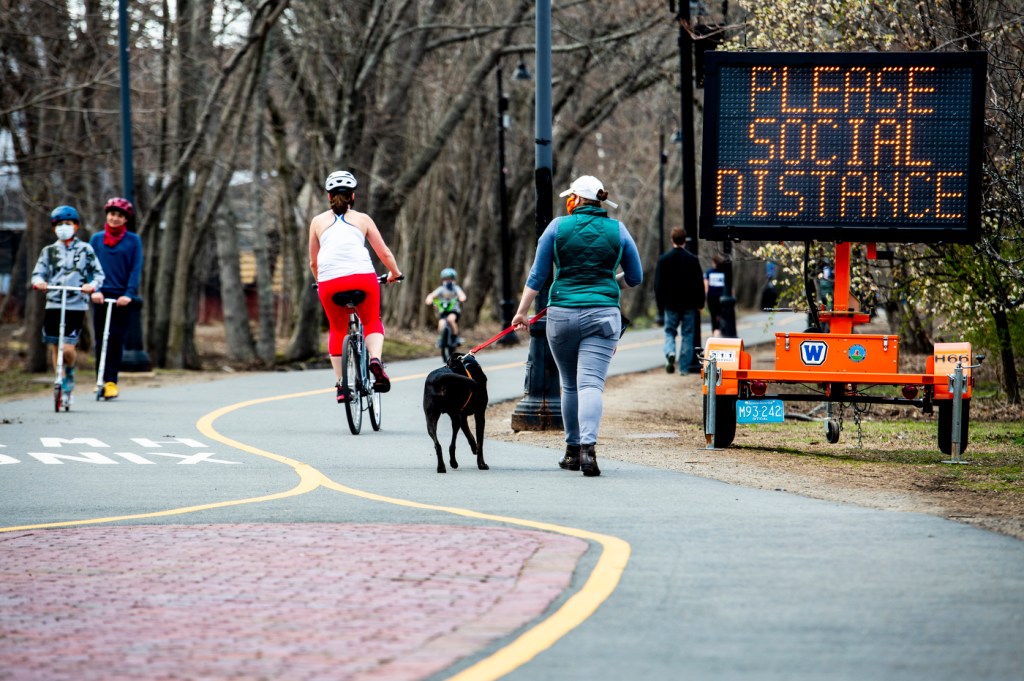Bans on large gatherings? Stay-at-home orders? Which ‘social distancing’ policies are actually working?

Bans on large gatherings. Restaurant and bar limits. Stay-at-home orders. School cancellations. Non-essential business closures.
State governments across the United States are implementing policies to keep people in their houses to reduce the spread of COVID-19. But different states have chosen different tactics.
Which of these policies are actually effective at keeping people home and encouraging ‘social distancing’? Babak Heydari, an associate professor of mechanical and industrial engineering at Northeastern, decided to find out.

Babak Heydari is an associate professor of mechanical and industrial engineering at Northeastern. Photo by Matthew Modoono/Northeastern University
“It’s hard to separate these effects in most of the other countries because there’s a centralized policy mechanism,” Heydari says. “In the U.S., because every state is in charge of its own policy, we have a diversity in the types of policies that different states implement, and we have a lag in the timing of these policies even when they implement the same one. This creates a kind of natural experiment testbed for answering these types of questions.”
Heydari and Rahi Abouk, an economist at William Paterson University, used the dates that states implemented various policies to analyze data released by Google that showed how much people moved around on a daily basis in the month of March.
The first thing they spotted was that people started staying home even before they were told to.
“In every single state, maybe with the exception of one or two, the reduction starts before even the first policy went into place,” Heydari says. “So that points to the importance of separating the effects of awareness from the effects of policies.”
News of the outbreak spread faster than policy-makers could decide which measures to take. In early March, many people began to change their behavior voluntarily. The researchers needed to separate out these actions, as well as account for weather, days of the week, and other factors that might affect how much the average person travels.
Their results showed that some policies worked much better than others.
“The most effective one, not surprisingly, is the stay-at-home policy,” Heydari says. “We show that has a causal impact—it’s six times more effective, in terms of reducing mobility, compared to not doing it.”
Policies mandating the closure of non-essential businesses, as well as restaurants and bars, showed a smaller, but still significant, impact.
“But the rest of the policies, like large-gathering bans and school closures, we see a decrease even in the states that have only those policies, but the decrease is not causal,” Heydari says. “We can attribute it to voluntary responses and awareness mechanisms.”
On their own, these policies may change people’s behavior. But by the time they were in place, the reduction in people’s movements had already happened, thanks to individual concerns about spreading the virus or because of small-scale changes, such as businesses encouraging employees to work from home.
“If you want to gain from social distancing policy, at least in the earlier stages of an outbreak, you have to go for the stronger policies, stay-at-home being the most effective one,” Heydari says.
That’s not to say closing schools or prohibiting large gatherings is a bad idea. The virus spreads relatively easily and schools in particular can be hotbeds for diseases. The researchers examined specifically how policies impacted our daily movements, not how they affected the number of cases or the number virus-related deaths.
It’s too soon to do those analyses, Heydari says, given the prolonged incubation period of the virus. The researchers are collecting data, but policy changes will need to be in place for several weeks before they begin to make a noticeable difference in the infection rate.
But they definitely make a noticeable difference in the rate at which people are coming in contact with one another, which should help slow the spread of COVID-19. And states that have only closed schools or limited large gatherings should be considering stronger policies, Heydari says.
“Even if you have already seen a reduction in social contact rate, you can still benefit from these stronger policies,” Heydari says. “Many states are still in the early stage of the outbreak. So it’s better late than never.”
For media inquiries, please contact Mike Woeste at m.woeste@northeastern.edu or 617-373-5718.





